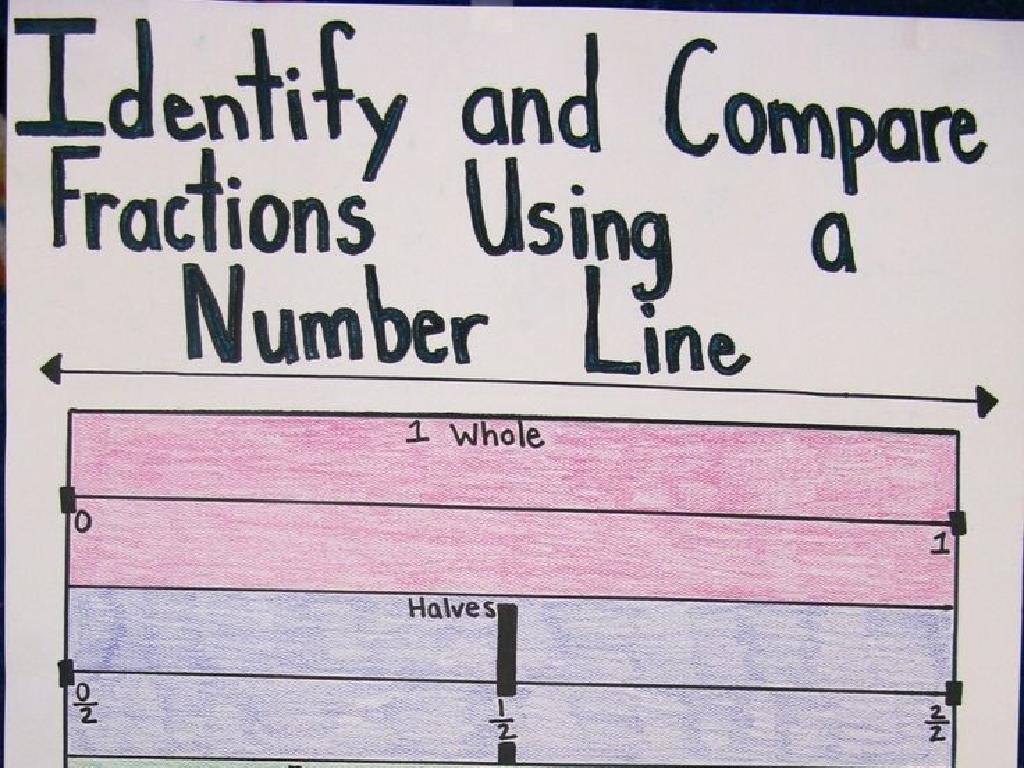Create Line Plots
Subject: Math
Grade: Fifth grade
Topic: Data And Graphs
Please LOG IN to download the presentation. Access is available to registered users only.
View More Content
Today’s Adventure: Creating Line Plots!
– Organizing data with line plots
– Line plots show data along a number line
– Line plots in daily life
– Used to compare prices, track changes over time
– Steps to create a line plot
– Gather data, choose a scale, plot points, connect them
– Practice with real data
– We’ll use class survey data to make our own line plot
|
This slide introduces the concept of line plots to the students, emphasizing their role in organizing data in a visual format. Explain that line plots are a type of graph that displays data along a number line, which is useful for seeing the frequency of data points. Discuss how line plots are used in everyday life, such as comparing prices at a store or tracking temperature changes over a week. Walk the students through the steps of creating a line plot: collecting data, choosing an appropriate scale for the number line, plotting the data points, and connecting them if necessary. To reinforce the lesson, engage the students in a hands-on activity where they will use data from a class survey to create their own line plot. This practical application will help solidify their understanding of the concept.
Understanding Line Plots
– What is a line plot?
– A graph that shows frequency of data along a number line
– ‘X’ marks the frequency
– Each ‘X’ above a number shows how often it appears in the data set
– Visualizing data distribution
– Line plots display how data is spread out
– Easy comparison of data
|
A line plot is a simple and effective way to display data, especially when dealing with smaller sets of numbers or measurements. It’s constructed by marking an ‘X’ above a number on a number line each time that value appears in the set. This visual representation allows students to quickly assess the frequency of data points and understand the distribution. For example, if we collect data on the number of books students read in a month, each ‘X’ can represent one student. This slide will introduce the concept of line plots and how they are used to organize and interpret data. Encourage students to think about why it might be easier to understand data when it’s presented in this way, compared to just a list of numbers.
Key Components of a Line Plot
– Number line representation
– A horizontal line with numbers to place data
– Plotting data points
– Values that you measure or count
– ‘X’ marks frequency
– Each ‘X’ shows how many times a data point appears
– Title of the line plot
– Describes the information the plot is showing
|
This slide introduces the essential elements of a line plot, which is a tool used in math to organize data visually. Start by explaining the number line, which is the foundation of the line plot where all data points will be placed. Each data point represents a value that has been measured or counted. The ‘X’ marks are used to indicate the frequency of each data point, showing how often it occurs. The title is crucial as it provides context to the data, letting us know what is being represented. Encourage students to think of their own examples of data that could be organized into a line plot, such as their daily reading minutes or the number of each type of fruit in a fruit salad.
Creating Our Line Plot
– Step 1: Collect data
– Gather information you want to graph
– Step 2: Decide scale & interval
– Choose even spacing for numbers on the plot
– Step 3: Draw & label number line
– A horizontal line with numbers showing scale
– Step 4: Plot data with Xs
– Mark each data point above its value on the line
|
This slide outlines the steps to create a line plot, which is a type of graph that displays data along a number line. First, students need to collect the data they will be graphing. Next, they must determine the scale and interval to ensure that the data is represented accurately and clearly. The number line should then be drawn and labeled with the appropriate scale. Finally, students will plot the data points by marking Xs above the corresponding values on the number line. Encourage students to ensure their Xs are aligned and to double-check their work for accuracy. As an activity, students can collect data on a topic of interest, such as favorite fruits or shoe sizes, and create their own line plots.
Creating Line Plots from Survey Data
– Survey: Favorite Fruits of Students
– Tally the fruit each student likes
– Convert data into a line plot
– Plot points above a number line to represent data
– Interpret the line plot
– Analyze the plot to see which fruit is most popular
– Discuss insights from the plot
|
This slide is aimed at teaching students how to create and interpret line plots. Start with a simple survey on favorite fruits to collect data. Show students how to tally the number of students who like each fruit and then convert this information into a line plot by placing dots above a number line corresponding to each fruit’s tally count. Discuss how to read the line plot, such as identifying which fruit is most or least popular, and what this tells us about the group’s preferences. Encourage students to think about why this type of graph is useful for presenting data clearly and effectively.
Practice Time: Let’s Create a Line Plot!
– Collect class reading data
– How many books did each student read?
– Pair up for data collection
– Work with a classmate to gather information
– Draw your line plot
– Use a number line and X’s to represent data
– Share your plot with the class
– Present your findings to everyone
|
This slide is designed for a hands-on activity where students will apply their knowledge of line plots. Start by discussing the importance of collecting data and how it can be visually represented. Students should pair up and ask each other how many books they’ve read in the past month, recording the data. Then, they will use this data to create a line plot, marking each book read with an ‘X’ above the corresponding number on a number line. Encourage creativity but ensure accuracy in their representation. After completing their line plots, each pair will present their findings to the class, explaining their data collection process and how they chose to represent it. This activity will reinforce their understanding of line plots and data interpretation.
Understanding Our Line Plots
– What line plots reveal
– Line plots display frequency of data along a number line.
– Identifying patterns
– Look for repeated data or intervals with more points.
– Finding the most common point
– The data point with the most X’s above it on the plot.
– Discovering the least common point
– The data point with the fewest X’s above it on the plot.
|
This slide aims to help students interpret information from line plots. Start by explaining that a line plot is a way to organize data along a number line and that each ‘X’ above a number represents how often that data point occurs. Encourage students to look for patterns, such as clusters of data points or gaps, which can indicate trends. Discuss how to identify the most common data point (mode) by finding the number with the most X’s above it. Similarly, identify the least common data point by finding the number with the fewest X’s. Use examples relevant to fifth graders, such as the number of books read or the number of steps taken in a day, to make the concept more relatable. In the next class, students can create their own line plots using data collected from a class survey or experiment.
Class Activity: Exploring Our Reading Habits
– Collect book reading data
– Each student states how many books they’ve read
– Create a line plot as a class
– Use the data to draw points on a number line
– Analyze our class reading habits
– What does the plot tell us about how much we read?
– Discuss findings and observations
– Share thoughts on our reading trends and outliers
|
This interactive class activity is designed to engage students with data collection and visualization through a line plot. Start by having each student share the number of books they have read, which will be the data for the plot. Then, as a class, create a line plot on the board, marking each data point on a number line. Once the plot is complete, lead a discussion on what the line plot reveals about the class’s reading habits. Encourage students to observe patterns, averages, and any outliers in the data. This activity notifies students about the importance of data in understanding trends and making decisions. It also fosters a sense of community as students learn about their classmates’ reading interests. Provide guidance on how to create and interpret line plots, ensuring that each student understands the process and purpose.
Conclusion & Homework: Line Plots
– Excellent work on line plots!
– Homework: Chart family shoe sizes
– Measure and list the shoe sizes of your family members
– Create your own line plot
– Use the data to draw a line plot on graph paper
– Share your plot in class tomorrow
|
Today’s lesson focused on understanding and creating line plots, which are a type of graph that displays data along a number line. For homework, students are tasked with applying what they’ve learned by collecting real-world data – their family’s shoe sizes. They will measure and list the sizes, then create a line plot to visually represent this data. This exercise will reinforce their skills in data collection and graphing, and prepare them to present and interpret their findings in the next class. Encourage creativity and accuracy in their plots. Remind them to label their axes and to use a ruler for precision. This activity will also help them understand the variability and distribution of data in a fun and personal context.


/convergence_divergence_history.png)


